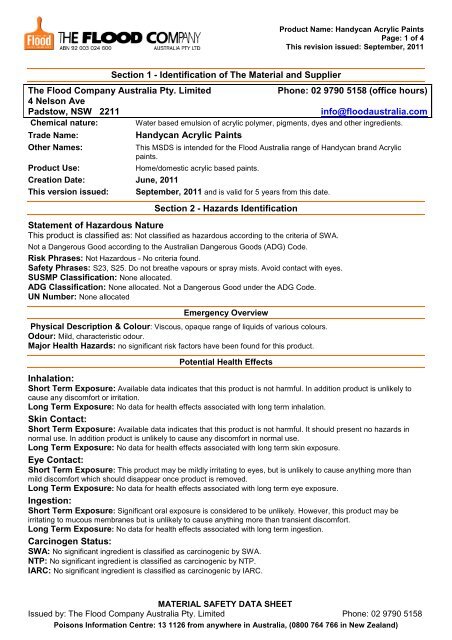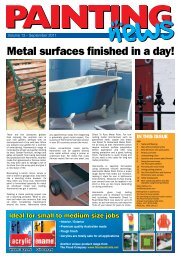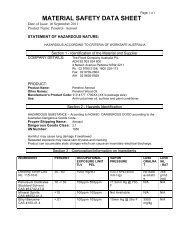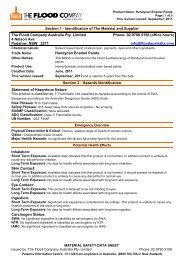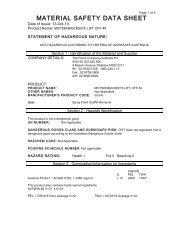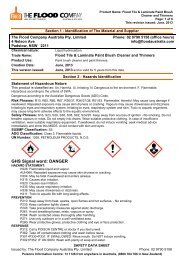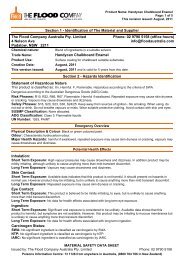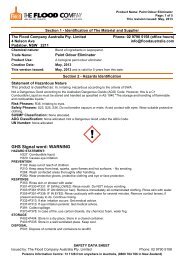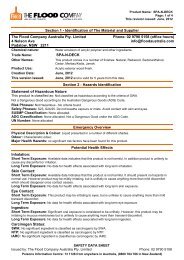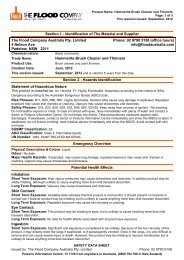MSDS Handycan Acrylic Paints
MSDS Handycan Acrylic Paints
MSDS Handycan Acrylic Paints
Create successful ePaper yourself
Turn your PDF publications into a flip-book with our unique Google optimized e-Paper software.
Product Name: <strong>Handycan</strong> <strong>Acrylic</strong> <strong>Paints</strong>Page: 3 of 4This revision issued: September, 2011Section 7 - Handling and StorageHandling: Keep exposure to this product to a minimum, and minimise the quantities kept in work areas. CheckSection 8 of this <strong>MSDS</strong> for details of personal protective measures, and make sure that those measures are followed.The measures detailed below under "Storage" should be followed during handling in order to minimise risks topersons using the product in the workplace. Also, avoid contact or contamination of product with incompatiblematerials listed in Section 10.Storage: Make sure that containers of this product are kept tightly closed. Make sure that the product does not comeinto contact with substances listed under "Incompatibilities" in Section 10. Some liquid preparations settle or separateon standing and may require stirring before use. Check packaging - there may be further storage instructions on thelabel.Section 8 - Exposure Controls and Personal ProtectionThe following Australian Standards will provide general advice regarding safety clothing and equipment:Respiratory equipment: AS/NZS 1715, Protective Gloves: AS 2161, Occupational Protective Clothing: AS/NZS 4501set 2008, Industrial Eye Protection: AS1336 and AS/NZS 1337, Occupational Protective Footwear: AS/NZS2210.SWA Exposure Limits TWA (mg/m 3 ) STEL (mg/m 3 )Exposure limits have not been established by SWA for any of the significant ingredients in this product.No special equipment is usually needed when occasionally handling small quantities. The following instructions arefor bulk handling or where regular exposure in an occupational setting occurs without proper containment systems.Ventilation: This product should only be used in a well ventilated area. If natural ventilation is inadequate, use of afan is suggested.Eye Protection: Eye protection is not normally necessary when this product is being used. However, if in doubt,wear suitable protective glasses or goggles.Skin Protection: The information at hand indicates that this product is not harmful and that normally no special skinprotection is necessary. However, we suggest that you routinely avoid contact with all chemical products and that youwear suitable gloves (preferably elbow-length) when skin contact is likely.Protective Material Types: We suggest that protective clothing be made from the following: rubber, PVC.Respirator: Usually, no respirator is necessary when using this product. However, if you have any doubts consultthe Australian Standard mentioned above.Section 9 - Physical and Chemical Properties:Physical Description & colour: Viscous, opaque range of liquids of various colours.Odour:Mild, characteristic odour.Boiling Point:Approximately 100°C at 100kPa.Freezing/Melting Point: Below 0°C.Volatiles:Not available.Vapour Pressure:2.37 kPa at 20°C (water vapour pressure).Vapour Density:No data.Specific Gravity: 1.0-1.0Water Solubility:Completely soluble in water (although some pigments may settle out onstanding.pH:No data.Volatility:No data.Odour Threshold:No data.Evaporation Rate:No data.Coeff Oil/water Distribution: No dataAutoignition temp:Not applicable - does not burn.Section 10 - Stability and ReactivityReactivity: This product is unlikely to react or decompose under normal storage conditions. However, if you haveany doubts, contact the supplier for advice on shelf life properties.Conditions to Avoid: Keep containers tightly closed.Incompatibilities: strong acids, strong bases, strong oxidising agents.Fire Decomposition: Only small quantities of decomposition products are expected from this product attemperatures normally achieved in a fire. This will only occur after heating to dryness. Combustion forms carbonMATERIAL SAFETY DATA SHEETIssued by: The Flood Company Australia Pty. Limited Phone: 02 9790 5158Poisons Information Centre: 13 1126 from anywhere in Australia, (0800 764 766 in New Zealand)
Product Name: <strong>Handycan</strong> <strong>Acrylic</strong> <strong>Paints</strong>Page: 4 of 4This revision issued: September, 2011dioxide, and if incomplete, carbon monoxide and smoke. Water is also formed. May form nitrogen and its compounds,and under some circumstances, oxides of nitrogen. Occasionally hydrogen cyanide gas in reducing atmospheres.May form oxides of sulfur (sulfur dioxide is a respiratory hazard) and other sulfur compounds. Most will have a foulodour. Carbon monoxide poisoning produces headache, weakness, nausea, dizziness, confusion, dimness of vision,disturbance of judgment, and unconsciousness followed by coma and death.Polymerisation: Polymerisation reactions are unlikely; they are not expected to occur.Section 11 - Toxicological InformationLocal Effects:Target Organs:There is no data to hand indicating any particular target organs.Classification of Hazardous IngredientsIngredientRisk PhrasesNo ingredient mentioned in the HSIS Database is present in this product at hazardous concentrations.Section 12 - Ecological InformationInsufficient data to be sure of status.Section 13 - Disposal ConsiderationsDisposal: Dispose of small quantities and empty containers by wrapping with paper and putting in garbage. Forlarger quantities, if recycling or reclaiming is not possible, use a commercial waste disposal service.Section 14 - Transport InformationADG Code: This product is not classified as a Dangerous Good. No special transport conditions are necessaryunless required by other regulations.Section 15 - Regulatory InformationAICS: All of the significant ingredients in this formulation are compliant with NICNAS regulations.Section 16 - Other InformationAcronyms:ADG CodeAICSSWACAS numberIARCNTPR-PhraseSUSMPUN NumberThis <strong>MSDS</strong> contains only safety-related information. For other data see product literature.Australian Code for the Transport of Dangerous Goods by Road and Rail (7 th edition)Australian Inventory of Chemical SubstancesSafe Work Australia, formerly ASCC and NOHSCChemical Abstracts Service Registry NumberInternational Agency for Research on CancerNational Toxicology Program (USA)Risk PhraseStandard for the Uniform Scheduling of Medicines & PoisonsUnited Nations NumberTHIS <strong>MSDS</strong> SUMMARISES OUR BEST KNOWLEDGE OF THE HEALTH AND SAFETY HAZARD INFORMATION OF THE PRODUCT ANDHOW TO SAFELY HANDLE AND USE THE PRODUCT IN THE WORKPLACE. EACH USER MUST REVIEW THIS <strong>MSDS</strong> IN THE CONTEXT OFHOW THE PRODUCT WILL BE HANDLED AND USED IN THE WORKPLACE.IF CLARIFICATION OR FURTHER INFORMATION IS NEEDED TO ENSURE THAT AN APPROPRIATE RISK ASSESSMENT CAN BE MADE,THE USER SHOULD CONTACT THIS COMPANY SO WE CAN ATTEMPT TO OBTAIN ADDITIONAL INFORMATION FROM OUR SUPPLIERSOUR RESPONSIBILITY FOR PRODUCTS SOLD IS SUBJECT TO OUR STANDARD TERMS AND CONDITIONS, A COPY OF WHICH IS SENTTO OUR CUSTOMERS AND IS ALSO AVAILABLE ON REQUEST.Please read all labels carefully before using product.This <strong>MSDS</strong> is prepared in accord with the SWA document “National Code of Practice for the Preparation ofMaterial Safety Data Sheets” 2nd Edition [NOHSC:2011(2003)]Copyright © Kilford & Kilford Pty Ltd, September, 2011.http://www.kilford.com.au/ Phone (02)9251 4532MATERIAL SAFETY DATA SHEETIssued by: The Flood Company Australia Pty. Limited Phone: 02 9790 5158Poisons Information Centre: 13 1126 from anywhere in Australia, (0800 764 766 in New Zealand)


